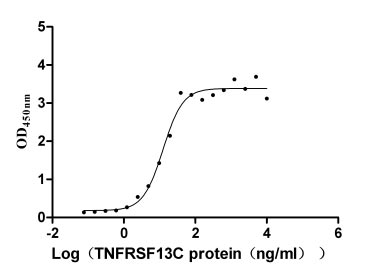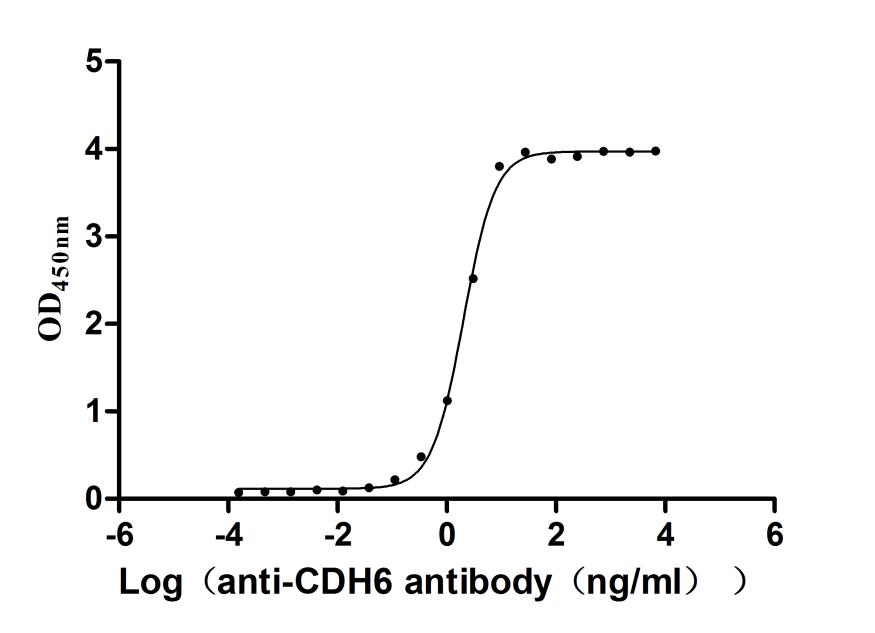Recombinant Mouse Myelin-oligodendrocyte glycoprotein (Mog), partial
-
中文名称:小鼠Mog重组蛋白
-
货号:CSB-YP726763MO1
-
规格:
-
来源:Yeast
-
其他:
-
中文名称:小鼠Mog重组蛋白
-
货号:CSB-EP726763MO1
-
规格:
-
来源:E.coli
-
其他:
-
中文名称:小鼠Mog重组蛋白
-
货号:CSB-EP726763MO1-B
-
规格:
-
来源:E.coli
-
共轭:Avi-tag Biotinylated
E. coli biotin ligase (BirA) is highly specific in covalently attaching biotin to the 15 amino acid AviTag peptide. This recombinant protein was biotinylated in vivo by AviTag-BirA technology, which method is BriA catalyzes amide linkage between the biotin and the specific lysine of the AviTag.
-
其他:
-
中文名称:小鼠Mog重组蛋白
-
货号:CSB-BP726763MO1
-
规格:
-
来源:Baculovirus
-
其他:
-
中文名称:小鼠Mog重组蛋白
-
货号:CSB-MP726763MO1
-
规格:
-
来源:Mammalian cell
-
其他:
产品详情
-
纯度:>85% (SDS-PAGE)
-
基因名:Mog
-
Uniprot No.:
-
别名:Mog; Myelin-oligodendrocyte glycoprotein
-
种属:Mus musculus (Mouse)
-
蛋白长度:Partial
-
蛋白标签:Tag type will be determined during the manufacturing process.
The tag type will be determined during production process. If you have specified tag type, please tell us and we will develop the specified tag preferentially. -
产品提供形式:Lyophilized powder
Note: We will preferentially ship the format that we have in stock, however, if you have any special requirement for the format, please remark your requirement when placing the order, we will prepare according to your demand. -
复溶:We recommend that this vial be briefly centrifuged prior to opening to bring the contents to the bottom. Please reconstitute protein in deionized sterile water to a concentration of 0.1-1.0 mg/mL.We recommend to add 5-50% of glycerol (final concentration) and aliquot for long-term storage at -20℃/-80℃. Our default final concentration of glycerol is 50%. Customers could use it as reference.
-
储存条件:Store at -20°C/-80°C upon receipt, aliquoting is necessary for mutiple use. Avoid repeated freeze-thaw cycles.
-
保质期:The shelf life is related to many factors, storage state, buffer ingredients, storage temperature and the stability of the protein itself.
Generally, the shelf life of liquid form is 6 months at -20°C/-80°C. The shelf life of lyophilized form is 12 months at -20°C/-80°C. -
货期:Delivery time may differ from different purchasing way or location, please kindly consult your local distributors for specific delivery time.Note: All of our proteins are default shipped with normal blue ice packs, if you request to ship with dry ice, please communicate with us in advance and extra fees will be charged.
-
注意事项:Repeated freezing and thawing is not recommended. Store working aliquots at 4°C for up to one week.
-
Datasheet :Please contact us to get it.
相关产品
靶点详情
-
功能:Minor component of the myelin sheath. May be involved in completion and/or maintenance of the myelin sheath and in cell-cell communication. Mediates homophilic cell-cell adhesion.
-
基因功能参考文献:
- The aim of this work was to explore the conformational characteristics of rat/mouse MOG35-55 immunodominant epitope. The results are discussed in terms of rational design of altered peptide ligands or non-peptide mimetics based on rat MOG35-55 that could be served as potential inhibitors of experimental autoimmune encephalomyelitis PMID: 27483998
- Identify nerve growth factor as a binding partner for MOG and demonstrate that this interaction is capable of sequestering NGF from TrkA-expressing neurons to modulate axon growth and survival. PMID: 26347141
- the absence of N-glycan did not interfere with MOG's subcellular localization and it did not result in activation of endoplasmic reticulum stress. PMID: 25541284
- Data indicate that in mixed chimeras with bone marrow-encoding myelin oligodendrocyte glycoprotein (MOG), the development of MOG-specific B cells was abrogated, resulting in a lack of MOG-specific B cells in all B cell compartments examined. PMID: 24532581
- Different forms of evolution of optic neuritis are observed in this animal model suggest that variations of biosynthetic MOG35-55 peptide concentration are capable of inducing different profiles of optic neuritis. PMID: 24083391
- Identify immunogenic/encephalitogenic T-cell epitopes within MOG capable of inducing experimental autoimmune encephalomyelitis in C57BL/6 mice. PMID: 23876060
- PLP significantly suppresses both models of experimental autoimmune encephalitis (EAE)even when there is some evidence of epitope spreading in the myelin oligodendrocyte (MOG)38-50-induced EAE model. PMID: 23911075
- CNTF may play a role in the process of remyelination by inducing the MOG expression. PMID: 23443463
- MOG-specific CD4-positive T cells accumulate within the chemokine-expressing draining lymph nodes, rather than within the brain or spinal cord during induction of autoimmune encephalomyelitis. PMID: 22287719
- This study provides valuable information about requirements of anti-myelin oligodendrocyte glycoprotein reactivity for being regarded as a prognostic biomarker in a subtype of MS. PMID: 22093619
- Mice immunized with encephalitogenic myelin oligodendrocyte glycoprotein MOG(35-55) peptide develop significant serum levels of anti-MOG antibodies in parallel with disease progression. PMID: 21993076
- B cell-deficient mice exhibit reduced medullary thymic epithelial cell numbers and reduced MOG mRNA expression. PMID: 21550671
- Cell surface targeting of MOG is not disrupted in the absence of the endoplasmic reticulum chaperones. PMID: 21172390
- MOG self-tolerance modulates the encephalitogenic potential of autoreactive MOG T cells in the periphery. PMID: 14624757
- The core epitope of immunodominant 35-55 peptide (pMOG) fragment has the potential to be citrullinated at two T cell receptor contact residues 41-Arg and 46-Arg, allowing an expanded repertoire of T cells to contribute to encephalomyelitis etiopathology. PMID: 20164413
- lack of systemic complement at the time of induction of EAE delays the onset and attenuates the course of the disease most probably via diminishing the response of MOG-specific T cells and production of autoantibodies PMID: 19201476
- The encephalitogenic peptide of intact MOG protein (resides 35-55) must be processed and presented via a functioning class II-restricted antigen processing pathway in the central nervous system in order to initiate autoimmune demyelinating disease. PMID: 11937578
- role in development of spontaneous autoimmune optic neuritis PMID: 12732654
- MOG has a role in immune tolerance and in experimental autoimmune encephalomyelitis PMID: 12925695
- Treatment of oligodendrocytes with anti-MOG leads to an increase in calcium influx and activation of the MAPK/Akt pathways. PMID: 15634682
- Opticospinal encephalomyelitis mice B cells bind high dilutions of recombinant MOG, but not MOG peptide, and process and present it to autologous T cells. PMID: 16955140
- Ig heavy chainMOG mice spontaneously develop a severe form of experimental autoimmune encephalomyelitis. PMID: 16955141
- prevention of experimental autoimmune encephalomyelitis by treatment with embryonic stem cell-derived dendritic cells(ES-DC)-TRAIL/MOG is mediated by MOG-reactive CD4(+)CD25(+) Treg propagated by ES-DC-TRAIL/MOG PMID: 17202353
- Results describe T cell receptor (TCR) transgenic mice (relapsing-remitting [RR] mice) carrying a TCR specific for myelin oligodendrocyte glycoprotein (MOG) peptide 92-106. PMID: 19487416
- CD8+ T cells reactive to MOG37-46 are pro-inflammatory and traffic to the CNS; however, the presence of CD4+ T cells elicits more severe disease and sustained inflammation of the CNS. PMID: 19540601
- the ligation of CEACAM1 negatively regulates the severity of experimental autoimmune encephalomyelitis by reducing MOG(35-55)-specific induction of both interferon-gamma and interleukin-17 via invariant natural killer T cell-dependent mechanisms PMID: 19700760
- protein localization signal PMID: 11389181
显示更多
收起更多
-
亚细胞定位:Membrane; Multi-pass membrane protein.
-
蛋白家族:Immunoglobulin superfamily, BTN/MOG family
-
组织特异性:Found exclusively in the CNS, where it is localized on the surface of myelin and oligodendrocyte cytoplasmic membranes. Reduced expression levels are observed in jimpy and quacking dysmyelinating mutant mice.
-
数据库链接:
KEGG: mmu:17441
STRING: 10090.ENSMUSP00000099726
UniGene: Mm.210857
Most popular with customers
-
Recombinant Human Tumor necrosis factor receptor superfamily member 5 (CD40), partial (Active)
Express system: Mammalian cell
Species: Homo sapiens (Human)
-
Express system: Mammalian cell
Species: Homo sapiens (Human)
-
Recombinant Human Microtubule-associated protein tau (MAPT) (Active)
Express system: Mammalian cell
Species: Homo sapiens (Human)
-
Recombinant Human Tumor-associated calcium signal transducer 2 (TACSTD2), partial (Active)
Express system: Mammalian cell
Species: Homo sapiens (Human)
-
Recombinant Human Early activation antigen CD69 (CD69), partial (Active)
Express system: Mammalian cell
Species: Homo sapiens (Human)
-
Recombinant Human C-C chemokine receptor type 9 (CCR9)-VLPs (Active)
Express system: Mammalian cell
Species: Homo sapiens (Human)
-
Recombinant Mouse Cadherin-6(Cdh6),partial (Active)
Express system: Mammalian cell
Species: Mus musculus (Mouse)
-
Recombinant Human C-C chemokine receptor type 5 (CCR5)-VLPs (Active)
Express system: Mammalian cell
Species: Homo sapiens (Human)




-AC1.jpg)















